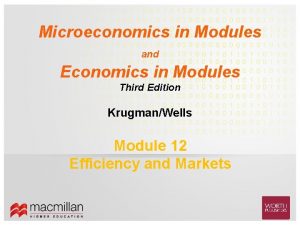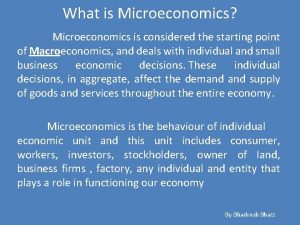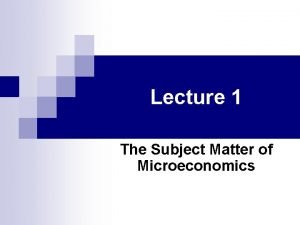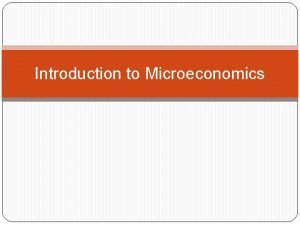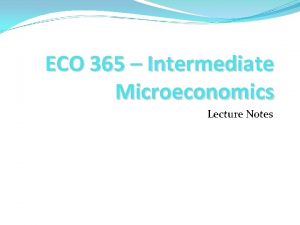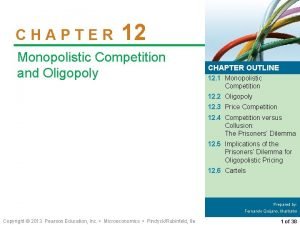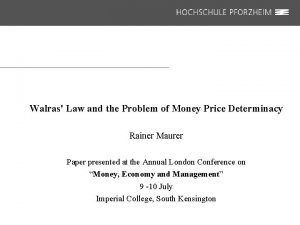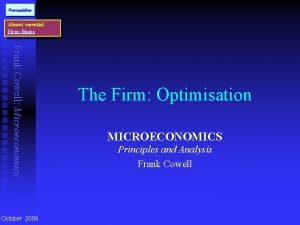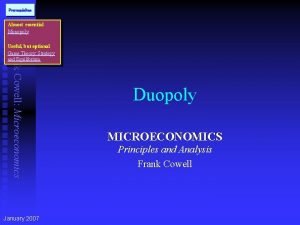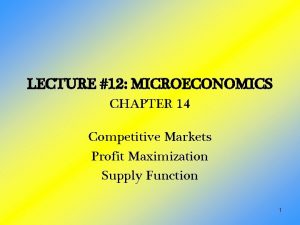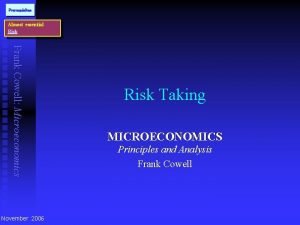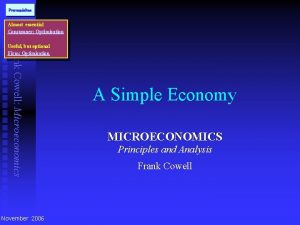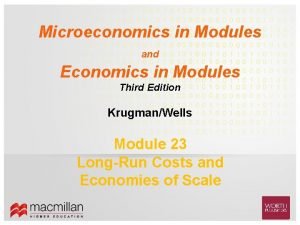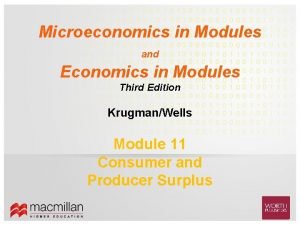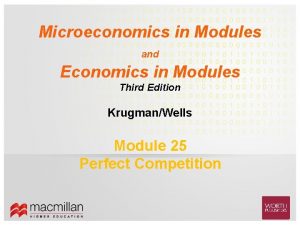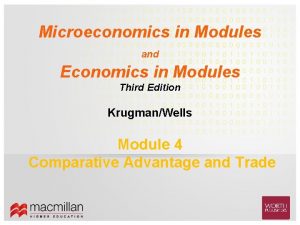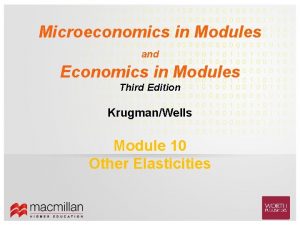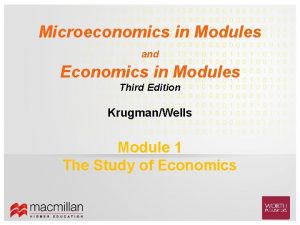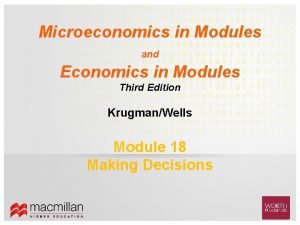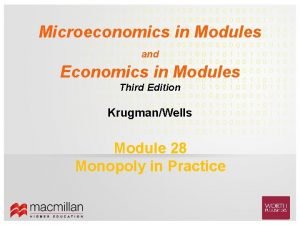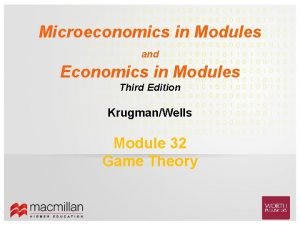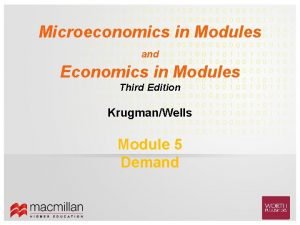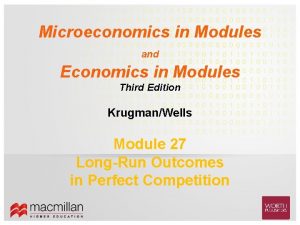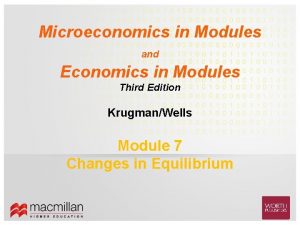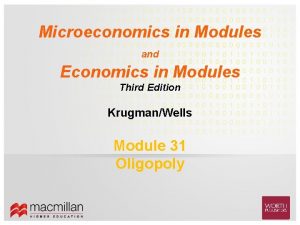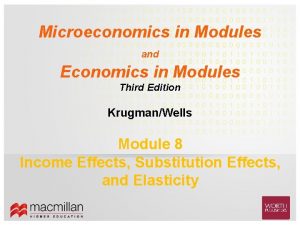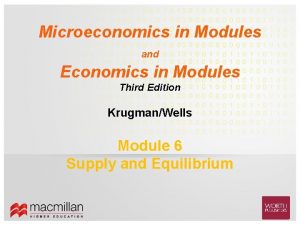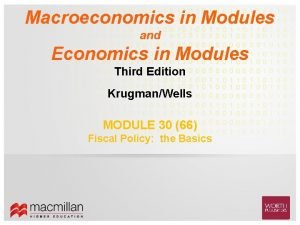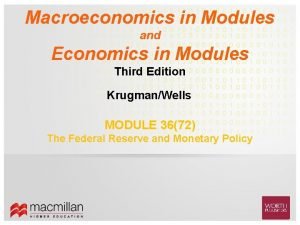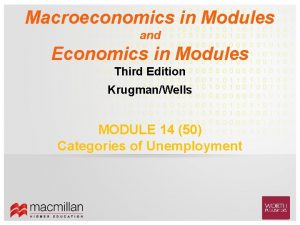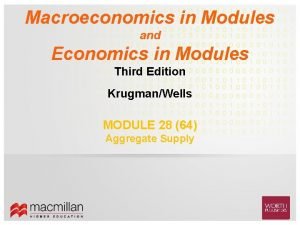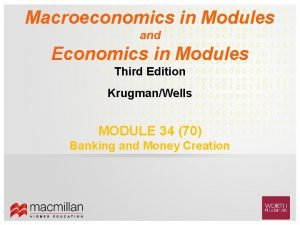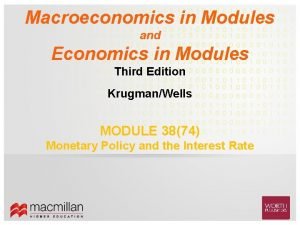Microeconomics in Modules and Economics in Modules Third


























- Slides: 26

Microeconomics in Modules and Economics in Modules Third Edition Krugman/Wells Module 22 Firm Costs

1 The various types of costs a firm faces, including fixed cost, variable cost, and total cost 2 How a firm’s costs generate marginal cost curves and average cost curves 2 of 26

From the Production Function to Cost Curves • A fixed cost does not depend on the quantity of output produced. • A fixed cost is the cost of the fixed input. • A variable cost depends on the quantity of output produced. • A variable cost is the cost of the variable input. 3 of 26

Total Cost Curve • The total cost of producing a given quantity of output is the sum of the fixed cost and the variable cost of producing that output. TC = FC + VC • The total cost curve becomes steeper as more output is produced; this is due to diminishing returns. 4 of 26

Total Cost Curve for George and Martha’s Farm Cost Total cost, TC $2, 000 I 1, 800 H 1, 600 G 1, 400 F 1, 200 E 1, 000 D 800 C 600 400 200 0 B A 19 36 51 64 75 84 91 96 Quantity of wheat (bushels) 5 of 26

Two Key Concepts: Marginal Cost and Average Cost As in the case of marginal product, marginal cost is equal to rise (the increase in total cost) divided by run (the increase in the quantity of output). 6 of 26

Costs at Selena’s Gourmet Salsas 7 of 26

Total Cost and Marginal Cost Curves for Selena’s Gourmet Salsas (a) Total Cost (b) Marginal Cost of case 8 th case of salsa increases total cost by $180. $1, 400 TC $250 MC 1, 200 2 nd case of salsa increases total cost by $36. 1, 000 800 150 600 100 400 50 200 0 1 2 3 4 5 6 7 8 9 10 Quantity of salsa (cases) 8 of 26

Why Is the Marginal Cost Curve Upward-Sloping? • There are diminishing returns to inputs in this example. • As output increases, the marginal product of the variable input declines. 9 of 26

Why Is the Marginal Cost Curve Upward-Sloping? • This implies that more and more of the variable input must be used to produce each additional unit of output as the amount of output already produced rises. • Since each unit of the variable input must be paid for, the cost per additional unit of output also rises. 10 of 26

Average Cost • Average total cost, often referred to simply as average cost, is total cost divided by quantity of output produced. ATC = TC/Q = (Total cost) / (Quantity of output) • A U-shaped average total cost curve falls at low levels of output, then rises at higher levels. • Average fixed cost is the fixed cost per unit of output. AFC = FC/Q = (Fixed cost) / (Quantity of output) 11 of 26

Average Cost • Average variable cost is the variable cost per unit of output. AVC = VC/Q = (Variable cost) / (Quantity of output) 12 of 26

Average Total Cost Curve • Increasing output has two opposing effects on average total cost: – The spreading effect: the larger the output, the greater the quantity of output over which fixed cost is spread, leading to lower average fixed cost. – The diminishing returns effect: the larger the output, the greater the amount of variable input required to produce additional units, leading to higher average variable cost. 13 of 26

Average Costs for Selena’s Gourmet Salsas 14 of 26

Average Total Cost Curve for Selena’s Gourmet Salsas Cost of case Average total cost, ATC $140 Minimum average total cost 120 100 M 80 60 40 20 0 1 2 3 4 Minimum-cost output 5 6 7 8 9 10 Quantity of salsa (cases) 15 of 26

Two Key Concepts: Marginal Cost and Average Cost • Marginal cost is upward-sloping because of diminishing returns. • Average variable cost also is upward-sloping but is flatter than the marginal cost curve. 16 of 26

Two Key Concepts: Marginal Cost and Average Cost • Average fixed cost is downward-sloping because of the spreading effect. • The marginal cost curve intersects the average total cost curve from below, crossing it at its lowest point. • This last feature is our next subject of study. 17 of 26

Marginal Cost and Average Cost Curves for Selena’s Gourmet Salsas Cost of case $250 The bottom of the U curve is at the level of output at which the marginal cost curve crosses the average total cost curve from below. MC Is this an accident? No! 200 150 ATC AVC 100 M 50 AFC 0 1 2 3 4 5 6 7 8 9 10 Quantity of salsa (cases) Minimum-cost output 18 of 26

Minimum Average Total Cost • The minimum-cost output is the quantity of output at which average total cost is lowest— the bottom of the U-shaped average total cost curve. 19 of 26

Minimum Average Total Cost 1. At the minimum-cost output, average total cost is equal to marginal cost. 2. At output less than the minimum-cost output, marginal cost is less than average total cost, and average total cost is falling. 3. And at output greater than the minimum-cost output, marginal cost is greater than average total cost, and average total cost is rising. 20 of 26

The Relationship Between the Average Total Cost and the Marginal Cost Curves Cost of unit If marginal cost is above average total cost, average total cost is rising. MC ATC MCH B 2 A 1 A 2 MCL M B 1 If marginal cost is below average total cost, average total cost is falling. Quantity 21 of 26

Does the Marginal Cost Curve Always Slope Upward? • In practice, marginal cost curves often slope downward as a firm increases its production from zero up to some low level. • This initial downward slope occurs because a firm that employs only a few workers often cannot reap the benefits of specialization of labor. 22 of 26

Does the Marginal Cost Curve Always Slope Upward? • This specialization can lead to increasing returns at first and so to a downward-sloping marginal cost curve. • Once there are enough workers to permit specialization, however, diminishing returns set in. 23 of 26

More Realistic Cost Curves Cost of unit 2. …but diminishing returns set in once the benefits from specialization are exhausted and marginal cost rises. MC ATC AVC 1. Increasing specialization leads to lower marginal cost, … Quantity 24 of 26

Summary 1. Total cost is equal to the sum of fixed cost, which does not depend on output, and variable cost, which does depend on output. 2. Average total cost, total cost divided by quantity of output, is the cost of the average unit of output, and marginal cost is the cost of one more unit produced. 3. U-shaped average total cost curves are typical, because average total cost consists of two parts: average fixed cost, which falls when output increases (the spreading effect), and average variable cost, which rises with output (the diminishing returns effect). 25 of 26

Summary 4. When average total cost is U-shaped, the bottom of the U is the level of output at which average total cost is minimized, the point of minimum-cost output. This is also the point at which the marginal cost curve crosses the average total cost curve from below. 26 of 26
 Economics modules
Economics modules Mount and hume classification
Mount and hume classification Gj mount classification of dental caries
Gj mount classification of dental caries Economics and business economics maastricht
Economics and business economics maastricht Principles of economics third edition pdf
Principles of economics third edition pdf Externalities and public goods microeconomics
Externalities and public goods microeconomics Microeconomics examples
Microeconomics examples Venn diagram of macroeconomics and microeconomics
Venn diagram of macroeconomics and microeconomics Mathematical economics vs non mathematical economics
Mathematical economics vs non mathematical economics Copy
Copy What is the subject matter of microeconomics
What is the subject matter of microeconomics Uses of microeconomics
Uses of microeconomics Intermediate microeconomics lecture notes
Intermediate microeconomics lecture notes Intermediate microeconomics notes
Intermediate microeconomics notes Cartel microeconomics
Cartel microeconomics Walras law
Walras law Frank cowell microeconomics solutions
Frank cowell microeconomics solutions Economics michael parkin 13th edition
Economics michael parkin 13th edition Objectives of microeconomics
Objectives of microeconomics Almost essential
Almost essential Microeconomics
Microeconomics Uses of microeconomics
Uses of microeconomics Example of macroeconomics
Example of macroeconomics Microeconomics chapter 12
Microeconomics chapter 12 Cowell microeconomics
Cowell microeconomics Frank cowell microeconomics
Frank cowell microeconomics Microeconomics examples
Microeconomics examples
